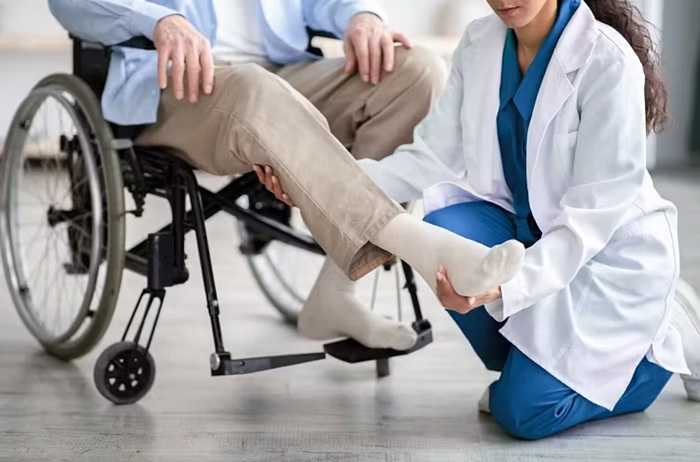
Expert Physiotherapy at Home
Certified physiotherapists visit you at home to provide focused, one-on-one care tailored to your needs. With no travel or waiting rooms, recovery happens in a setting that is comfortable, familiar, and built around your convenience.
Personalised Recovery Programmes
Every treatment plan is designed to suit your condition, goals, and pace. Our physiotherapists follow structured, evolving protocols to ensure consistent progress, with each session aligned to deliver meaningful results.
Trusted Physiotherapists. Real Results.
Our team comprises experienced, background-verified physiotherapists trusted by thousands of families. With a strong focus on safety, reliability, and clinical outcomes, we make recovery at home both effective and reassuring
Patient Testimonials
Portea Physiotherapists for Home Visits
Meet some of our experienced and dedicated healthcare professionals

Dr. Lokesh G
Physiotherapist
Specializations
Experienced in Neurological rehabilitation, Orthopaedic physiotherapy, and Paediatric care
Delivers structured, high-impact treatment plans across neuro, ortho, and paediatrics—ensuring safety, comfort, and measurable recovery at every stage.

Dr. Mohammed Sarwar
Physiotherapist
Specializations
Experienced in Neurological rehabilitation, Adult physiotherapy, and Paediatric care
Combines deep clinical expertise with a compassionate approach, supporting both adults and children through neuro and physical rehabilitation that promotes long-term independence and recovery.

Dr. Nelapati Divya
Physiotherapist
Specializations
Skilled in Orthopaedic rehabilitation, Manual therapy techniques, and Paediatric physiotherapy
Brings a personalised, hands-on approach to healing—combining structural expertise with paediatric sensitivity to restore movement, relieve pain, and improve everyday function.

Dr. Naveen V
Physiotherapist
Specializations
Trained in Pain management, Cardiac and Orthopaedic rehabilitation, Neurological care, and Neural tissue mobilisation
Brings clinical precision and empathy together—designing science-backed recovery protocols for pain relief, nerve mobilisation, and cardio-neuro-ortho rehabilitation across all age groups

Dr. Miloni Savla
Physiotherapist
Specializations
Holds an MPT in Orthopaedics with a focus on Musculoskeletal rehabilitation and strength recovery
Delivers focused, movement-oriented therapy grounded in orthopaedic science—helping patients rebuild strength, restore function, and return to daily life with confidence

introduction to monoparesis
Monoparesis refers to the partial paralysis or weakness of a single limb, caused by damage or dysfunction in the nervous system. This condition may arise suddenly or develop gradually, depending on the underlying cause. The impact of monoparesis can range from mild inconvenience to severe disability, often interfering with an individual’s ability to carry out everyday activities such as walking, grasping objects, or maintaining balance. Early detection and treatment play a vital role in managing this condition, minimizing its effects, and enhancing the quality of life.
recognizing the symptoms of monoparesis
The primary manifestation of monoparesis is a noticeable weakness in one limb, either an arm or a leg. Individuals may find it difficult to lift, move, or control the affected limb, which can lead to limitations in mobility or dexterity. In some cases, this weakness may be accompanied by additional symptoms such as numbness, tingling sensations, or a decrease in muscle mass, known as atrophy. Over time, the limb may exhibit abnormal reflexes or a significant reduction in muscle tone, further complicating movement and function. These symptoms should never be ignored, as they could indicate a serious underlying neurological condition that requires immediate attention.
causes of monoparesis
The development of monoparesis can be attributed to a variety of causes, each affecting the nervous system in distinct ways. Common causes include strokes, where blood flow to a specific part of the brain is interrupted, and traumatic brain or spinal cord injuries that disrupt nerve signals to the limb. Neurological disorders such as multiple sclerosis or conditions involving nerve compression, like herniated discs, are also frequent culprits. Infections, autoimmune diseases, and tumors affecting the central or peripheral nervous system can similarly result in monoparesis. Identifying the exact cause is essential for determining the most effective course of treatment.
understanding the risk factors of monoparesis
Several factors can increase the likelihood of developing monoparesis. Advanced age is a significant risk factor, as aging often leads to a decline in neurological health and resilience. A history of neurological conditions, such as stroke or multiple sclerosis, further elevates the risk. Chronic health problems like diabetes and hypertension, which can damage blood vessels and nerves, also contribute to the development of monoparesis. Additionally, lifestyle factors, including poor diet, physical inactivity, and exposure to repetitive trauma or injuries, can exacerbate susceptibility to conditions that may lead to monoparesis.
prevention and risk reduction for monoparesis
Although it is not always possible to prevent monoparesis, certain steps can be taken to reduce the risk and mitigate its impact. Maintaining a healthy lifestyle is paramount, including a balanced diet rich in nutrients, regular physical activity, and avoiding habits such as smoking or excessive alcohol consumption. Managing chronic conditions like diabetes, hypertension, and high cholesterol is equally important to preserve nerve and vascular health. Prompt medical attention for symptoms of neurological distress, such as sudden weakness or numbness, can prevent the progression of conditions that lead to monoparesis.
diagnosis and treatment approaches for monoparesis
Diagnosing monoparesis requires a comprehensive approach that begins with a detailed medical history and physical examination. Advanced diagnostic tools, such as magnetic resonance imaging (MRI), computed tomography (CT) scans, and nerve conduction studies, are often employed to pinpoint the cause and location of the nerve or brain damage. Treatment plans are tailored to address the underlying cause and may include medications to manage inflammation or pain, surgical interventions to relieve nerve compression, or therapeutic procedures to restore function.
Rehabilitation therapies play a crucial role in recovery, helping patients regain strength, mobility, and independence. These therapies often involve a combination of physical therapy, occupational therapy, and, in some cases, speech therapy if the condition affects more than just the limb.
the role of physiotherapy in monoparesis recovery
Physiotherapy is a cornerstone in the management and recovery of monoparesis. Through targeted exercises, physiotherapy aims to restore strength and functionality in the affected limb. Techniques such as electrical stimulation and manual therapy are often employed to stimulate muscle activity and reduce spasticity. Physiotherapists also focus on improving coordination and balance, allowing patients to perform daily activities with greater ease and confidence. By addressing the physical impairments associated with monoparesis and fostering neuroplasticity, physiotherapy significantly enhances the chances of achieving optimal recovery.
how portea makes a difference in monoparesis care
At Portea, we provide home-based physiotherapy services tailored to your unique needs, enabling you to recover in a safe and familiar environment. We also specialize in providing expert physiotherapy services for post-surgical rehab, arthritis, neuro-rehab, sports injury, orthopedic physiotherapy, physiotherapy for elderly, for respiratory disorders and more – all delivered conveniently at your home. Our dedicated team ensures you receive the personalized care you need for a smooth and successful recovery.
portea’s other physiotherapy services for various medical conditions
faq’s on monoparesis
1. What is monoparesis?
Monoparesis is a medical condition characterized by partial weakness or paralysis in one limb, which can significantly affect an individual’s ability to move or perform everyday activities.
2. How is monoparesis diagnosed?
Monoparesis is diagnosed through a combination of physical examinations, patient history, and imaging tests like MRI, CT scans, or nerve conduction studies to determine the underlying cause.
3. What causes monoparesis?
Monoparesis can be caused by several factors, including neurological conditions, brain injuries, infections, or trauma that disrupts nerve signals to one limb.
4. Can physiotherapy help with monoparesis?
Yes, physiotherapy plays a crucial role in the recovery process for monoparesis, helping individuals regain strength, mobility, and coordination in the affected limb.
5. What treatments are available for monoparesis?
Treatment for monoparesis depends on its cause. It may involve medications, surgery, and rehabilitation therapies, including physiotherapy and occupational therapy, to restore function and manage symptoms.
6. How long does it take to recover from monoparesis?
Recovery time for monoparesis varies based on the underlying cause, the severity of the condition, and the individual’s response to treatment. Early intervention and consistent rehabilitation can improve recovery outcomes.
7. Can monoparesis be prevented?
While not all cases of monoparesis can be prevented, maintaining a healthy lifestyle, managing chronic conditions, and seeking medical attention for neurological symptoms may reduce the risk.
8. What lifestyle changes can reduce the risk of monoparesis?
Adopting a healthy diet, staying physically active, managing conditions like hypertension and diabetes, and avoiding smoking or excessive alcohol consumption can help reduce the risk of developing monoparesis.
9. Can monoparesis affect both arms or legs?
No, monoparesis typically affects only one limb—either an arm or a leg. When both sides of the body are involved, it may indicate a different neurological condition.
10. What is the long-term outlook for people with monoparesis?
The long-term outlook depends on the cause of monoparesis. With proper medical treatment and physiotherapy, many individuals can regain some function and improve their quality of life.
Doctor Consultation
Nursing
Physiotherapy
Trained Attendant
Elder Care
Mother & Baby Care
Lab Tests
Medical Equipment
Speciality Pharma
Critical Care





